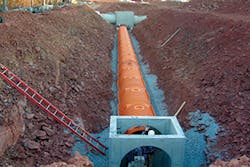Project Profile: Improving Water Quality at a Bronx Metal Recycling Facility
To be certain, these are challenging times for stormwater mitigation.
Water quality—as regulated by EPA and the Clean Water Act—is only as good as the approaches being used to achieve it. Those approaches should consider water quality not as a piecemeal approach, but a unified effort within watersheds, as recommended by the National Research Council.
That’s important when municipalities, design engineers, and private developers are trying to comply with the National Pollutant Discharge Elimination System Phase II and total maximum daily load requirements against the backdrop of limited space and limited budgets, which often call for creative design solutions.
Development brings an increased amount of impervious surfaces, and the natural flow of stormwater runoff is being altered as it enters streams and groundwater supplies. This also has brought about a greater amount of pollutants that are swept up and delivered in the flow, creating water-quality degradation that in urban streams is reaching levels with disconcerting human health, aquatic life, recreation, and economic implications. Aging infrastructure amplifies the challenges.
In New York City, StormChambers, manufactured by Hydrologic Solutions, have been used in conjunction with green infrastructure to eliminate a combined sewer overflow (CSO) problem at a metal recycling facility. Sims Metal Management Municipal Recycling (SMR) in the Bronx successfully recycles hundreds of tons of metals and plastics daily for the industrial and commercial sectors. The facility would often flood during rain events, with thousands of gallons of stormwater runoff heavily laden with metals, hydrocarbons, suspended solids, and other pollutants heading into the adjacent Bronx River.
Now, stormwater travels through a system of native plant meadow swales; an infiltration conveyance system composed, in part, of StormChambers; an evaporative wall; a created wetland; and a doubled-stacked underground detention/infiltration system consisting of 240 StormChambers and 15 StormChamber SedimenTraps that collectively collect, clean, and safely infiltrate the stormwater.
This was the first zero-discharge industrial retrofit of a material handling facility ever built in New York City, or the state, that was able to handle all runoff from a 10-year-or-larger storm through such an integrated system.
“In New York City, even one inch of rain can create a huge problem because all of the stormwater runoff goes into the sewer system, and the sewer system eventually ends up in the wastewater treatment plants,” says Professor Joshua Cheng of the Environmental Sciences Analytical Center at Brooklyn College of the City University of New York. “If the wastewater treatment can’t handle it, it gets released into the water bodies that are around the city and that includes all of the animal and human waste—whatever it is that is in there—that is going to the CSO.”
New York City does not have the capacity to handle one-inch rains, he points out, adding that the idea of the StormChamber system is to relieve the amount that goes into the sewer system and divert the water into green infrastructure.


